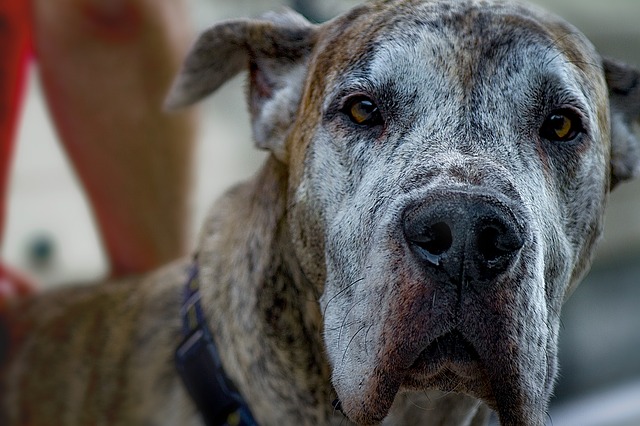As our dogs age, their health needs and problems change, too. As your dog approaches his senior years, vet visits are likely to change as a result. Each vet visit is an opportunity to find out how your dog’s health is doing and how you can help him live for many more healthy, happy years. It does take a little bit of preparation, but we’re here to help you get the most from your senior dog’s vet appointment.

When you make the appointment, ask if you should do or bring anything.
You may be asked to bring a urine or fecal sample, or you may be asked to fast your dog for 12 hours before the appointment. They should tell you these things when you make the appointment, but people get busy and may forget, so be sure to ask before you hang up the phone so you don’t wind up needing to come back at a later date or time with the things you need.
Bring medical records and medication, supplement, and vitamin information
This is especially important when you’re seeing a new vet, but it never hurts to bring this information to every appointment. If you have added or changed any supplements or vitamins in your dog’s routine, your vet will need that information.
Know your dog’s diet
Be prepared to answer questions about what, how much, and how often you feed your dog. Your vet may suggest changing your dog’s food to a senior formula, for example, or if your dog is overweight they may suggest that you feed less of what you’re currently feeding.
Bring a mat or a blanket
If your dog has aching, arthritic joints, lying on cold linoleum while you’re waiting to be seen can be painful. Consider bringing a mat or a blanket for him to lie on instead.
Keep your dog leashed while waiting
Even if your dog is calm and friendly at the vet, not every dog is the same. Keeping every dog on a leash helps prevent problems in the waiting room.

Be prepared to answer and ask questions.
Your vet will likely ask you lots of questions about your dog’s recent behavior, and you should be prepared to ask plenty of questions also. A vet appointment shouldn’t be just about examining your dog – it should include a long talk about the current state of his health, how it may change, what changes to look for, and how to keep him healthy as long as possible. Here are some questions you should consider asking at your senior dog’s vet visit.
At what age is my dog considered “senior”?
The old wisdom was that one dog year equaled 7 human years, but that isn’t entirely accurate. A dog is considered “senior” in the last quarter of their life. Since different sizes and breeds of dogs have different average lifespans, the age your dog is considered a senior will vary. Large and giant breeds can be considered senior as young as 6 years old, while toy breeds might not be considered senior until they’re 12. Ask your vet at what age he would consider your dog a senior since senior dogs have different health requirements than adult dogs.
Is there a difference between a senior dog health check and an adult health check?
As your dog ages, your vet may want to order more or different testing for your dog when you come in for appointments. Ask him what to expect going forward.

What health risks are common in senior dogs?
Just like humans, dogs are prone to many health problems as they age. Half of all dogs over the age of 10 will be diagnosed with cancer. Diabetes, kidney, and heart problems are also conditions that can manifest in senior dogs. Your vet may know of diseases that are more common in your breed of dog and what symptoms you should be on the lookout for.
How often should my dog come in?
While many adult dogs are fine with just one vet visit per year, your vet may recommend that your senior dog starts coming in twice a year. If your dog has a chronic health problem, he may need to come in even more frequently than that.
How is my dog’s weight?
Obesity is a big problem in our pets these days, with nearly half the dogs in this country considered overweight. Carrying around a few extra pounds can increase strain on arthritic joints and increase your dog’s likelihood of developing certain diseases, so it’s crucial to know how your dog’s weight is. Also, some diseases can cause weight gain or loss, so it’s important to have a baseline weight on your dog for your vet to notice any fluctuations.

How are my dog’s hips?
Many large and giant breeds are prone to hip dysplasia. The earlier you can catch it, the better you can manage it. If your vet doesn’t specifically check your dog’s hips, ask him to check them out.
Does my dog have arthritis?
As with people, arthritis is a common problem with aging dogs. The pain of arthritis can be managed with things like supplements, medication, and orthopedic dog beds, but you won’t be able to manage your dog’s pain if you aren’t aware that he’s experiencing any.
Is our exercise routine OK?
If your dog is overweight, he may need more exercise. If your dog is slowing down due to arthritis or hip dysplasia, he may need less or gentler exercise.
How is my dog’s diet?
Your vet may recommend that you change your dog’s diet as he ages. Senior dogs may have different nutritional needs than younger dogs, especially if they’re dealing with any chronic illnesses.

Does my dog need supplements?
Based on your dog’s overall health, your vet may recommend supplements such as an omega-3, glucosamine and chondroitin, or a probiotic. Ask your vet about the pros and cons of each supplement before deciding what’s best for your dog.
Do you need a blood, urine, or fecal sample?
Each of these tests will show something different, and your vet may or may not want to run various tests to help determine your dog’s overall health level.
What vaccinations does my dog need, and how often?
On the one hand, senior dogs have weaker immune systems and may need extra protection against certain illnesses. On the other hand, they may already have a lifetime’s worth of immunity from getting vaccinations every year, and the risk of administering additional vaccines (beyond rabies, which is usually mandatory) may outweigh the benefit.
How are his teeth and ears?
80% of dogs over the age of 4 show some level of periodontal disease. Having bad teeth can affect more than just his mouth – bacteria from inflamed gums can enter your dog’s bloodstream and affect his organs, including his heart. Your dog may need a dental cleaning under anesthesia to help remove plaque, tartar, and bacteria to help maintain his oral and overall health. On the other hand, the risk of anesthesia becomes greater as your dog ages, so your vet may not recommend a full cleaning under anesthesia.
Mild to moderate ear infections can go unnoticed by owners, but they can be uncomfortable for your dog, so make sure your vet takes a minute to peek inside his ears to check them out.

Is it normal for him to be slowing down?
Age itself is not a disease. If your dog is slowing down, it is likely a symptom of something else, such as arthritis or hip dysplasia. Ask your vet what might be causing your dog to slow down and what you can do about it.
Does my dog have tumors?
Tumors can hide in the craziest places that a pet owner may not notice. Some cancers are quite treatable if caught early, so ask your vet to check your dog thoroughly for tumors while you’re there.
Is it a good idea to add a new pet?
You may think your dog would love to have a friend to keep him company as he ages, but he may develop hearing loss, pain, or other factors that will make your dog less receptive to a new addition. Ask your vet if he thinks your dog would benefit or suffer from a new pet in the household.

How can I improve my dog’s quality of life?
Your vet may have plenty of suggestions on how to improve, or at least maintain, your dog’s overall quality of health.
(H/T: Caring For a Senior Dog, Petcha, Pet Care Rx)
via
Whisker Therapy








































